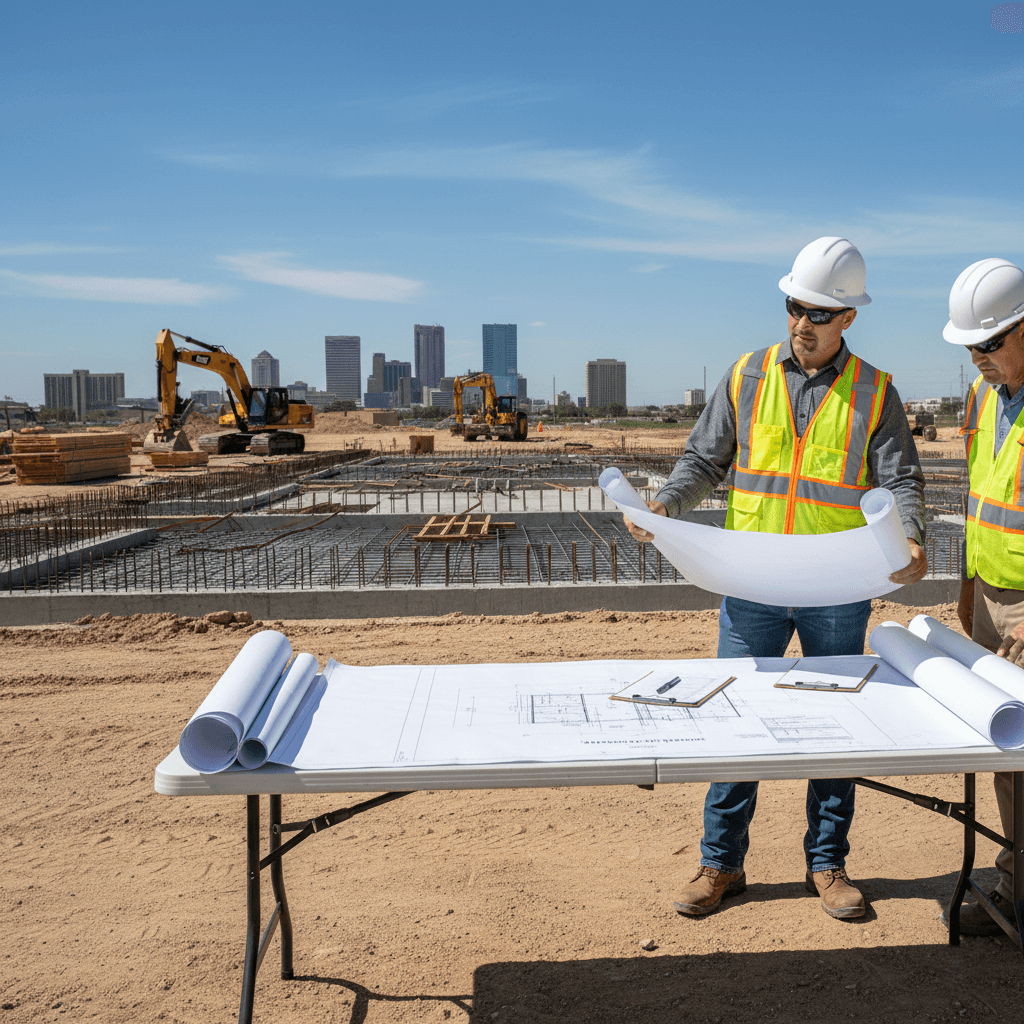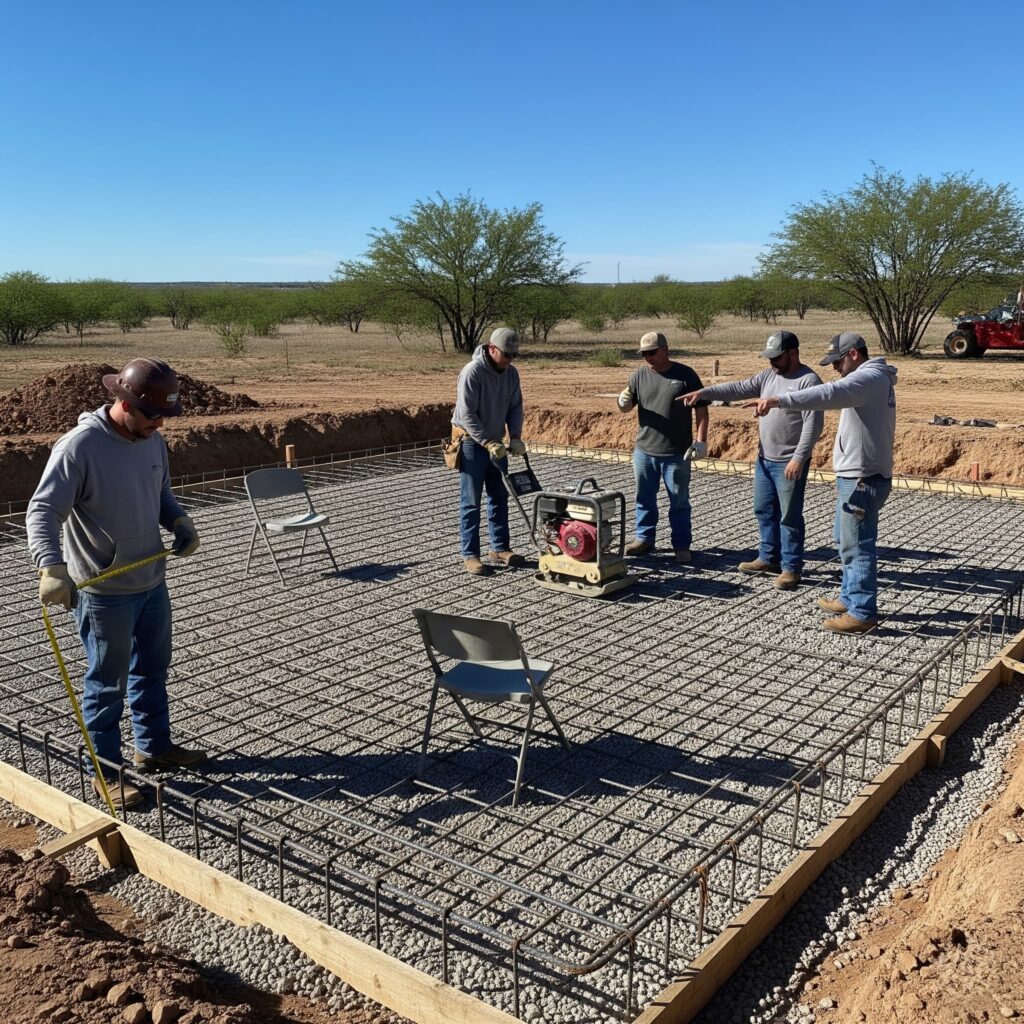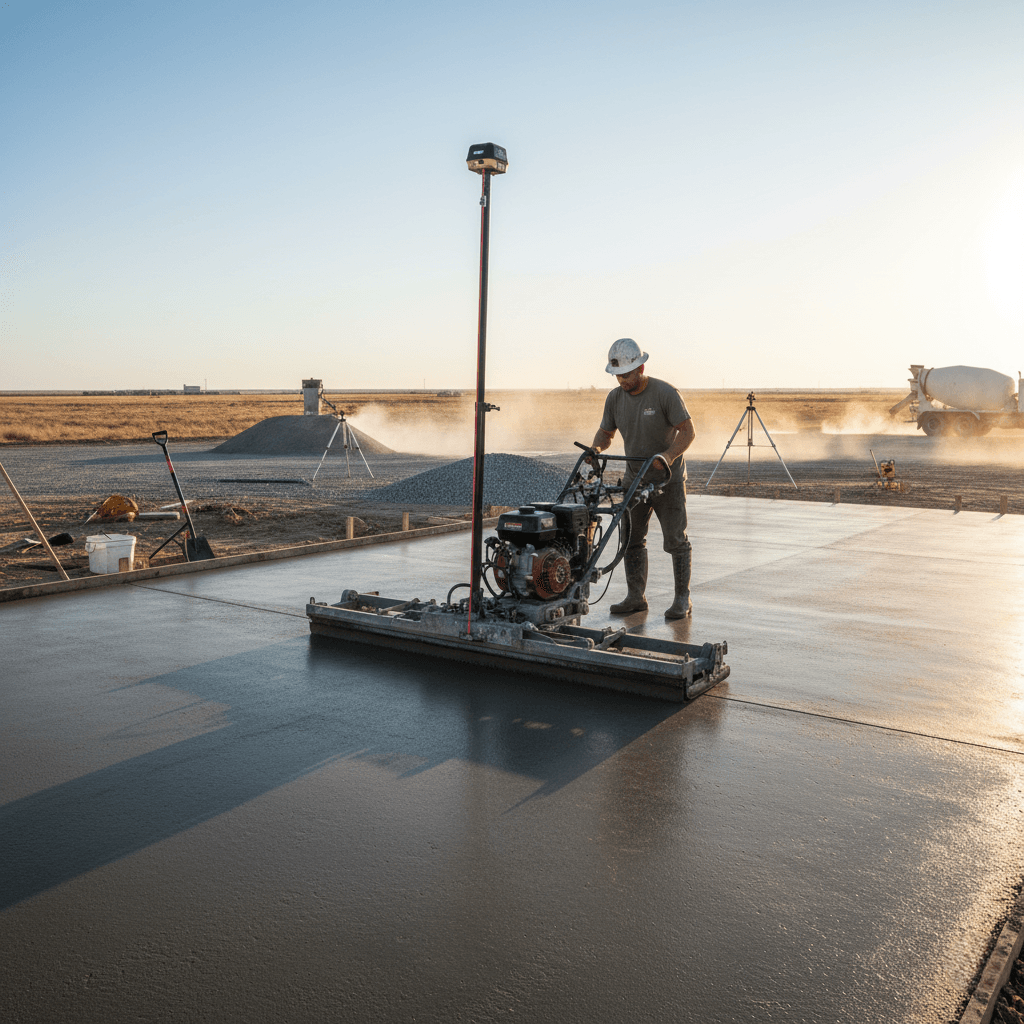
Midland Concrete Slabs: Soil Prep & Base Requirements
Concrete Slab Midland
Successful concrete slab construction in Midland depends heavily on proper soil preparation and base establishment that accounts for local geological conditions and climate factors. Understanding West Texas soil characteristics, drainage requirements, and foundation specifications ensures long-term structural integrity and prevents common problems like settling, cracking, or moisture infiltration. Professional site preparation involves multiple steps, including excavation, soil analysis, base material selection, compaction procedures, and reinforcement installation. The entire subbase and base system should be at least 4 inches thick—thicker if the engineer feels it is needed for proper support. Local soil conditions, particularly clay content and expansive characteristics, significantly influence preparation methods and material choices that determine project success and longevity.

Understanding Midland Soil Conditions
West Texas soil compositions present unique challenges that require specialized preparation techniques for concrete slab construction. Clay soils, common throughout the Midland area, exhibit expansive characteristics that cause significant volume changes with moisture fluctuations. These soils expand when wet and contract during dry periods, creating movement that can damage concrete structures without proper preparation and design considerations.
Cohesive soils are clays. If you take a wet handful, you can roll it into a string just like with modeling clay. Some clays expand when wet and shrink when dry, making them particularly difficult as subgrade materials. Understanding soil classification helps determine appropriate preparation methods and reinforcement requirements for specific project locations.
Caliche layers, hard calcium carbonate formations common in Central and West Texas, can provide stable foundation support when properly identified and utilized. However, caliche depth and consistency vary significantly across different areas, requiring professional soil analysis to determine suitability for foundation applications.
Areas near cultural landmarks like the historic Yucca Theatre, built in 1929, demonstrate long-term foundation performance in local soil conditions. These established structures provide valuable insight into successful foundation techniques that have proven effective over decades of service in Midland’s challenging environment.
Soil Testing and Analysis Requirements
Professional soil testing identifies key characteristics, including bearing capacity, moisture content, expansion potential, and drainage properties that influence foundation design. Laboratory analysis provides specific recommendations for excavation depth, base material requirements, and reinforcement specifications tailored to individual project conditions.
Excavation and Site Preparation
Proper excavation establishes the foundation for successful concrete placement while addressing drainage, utilities, and structural requirements. Excavation depth depends on intended slab use, soil conditions, frost protection needs, and local building code requirements. Residential applications typically require excavation depths of 8-12 inches below finished grade to accommodate base materials and slab thickness.
Site grading ensures proper water drainage away from concrete surfaces while establishing uniform support conditions. Final grade shall be sloped in accordance with local building codes to prevent water accumulation that can undermine foundation stability. Professional contractors use laser levels and surveying equipment to achieve precise grading that meets engineering specifications.
Utility coordination becomes critical during excavation to avoid damage to existing services and ensure proper placement of new utilities beneath or adjacent to concrete slabs. Underground electrical, plumbing, and gas lines require careful location and protection during excavation activities.
Areas near established venues like the Cole Theatre, part of Midland Community Theatre, showcase successful integration of utilities and foundation systems in challenging soil conditions. These installations demonstrate proper planning and execution techniques that prevent conflicts between infrastructure systems.
Excavation Safety and Quality Control
Excavation activities require adherence to safety protocols, including proper shoring, slope stabilization, and traffic control. Quality control measures ensure excavated surfaces meet design specifications for elevation, compaction, and material composition before base installation begins.
Base Material Selection and Installation
Base course material selection significantly impacts concrete performance and longevity. The base course material, according to ACI 302, “Concrete Floor and Slab Construction,” should be “compactible, easy to trim, granular fill that will remain stable and support construction traffic.” ACI 302 recommends material with 10 to 30% fines (passing the No. 100 sieve) with no clay, silt, or organic materials.
Processed gravel provides optimal characteristics for concrete slab bases, offering good drainage, stability, and compaction properties. Local suppliers in Midland offer various aggregate options, including crushed limestone, recycled concrete, and manufactured gravel that meet project specifications and provide cost-effective solutions.
A minimum thickness of 4-6 inches of well-compacted gravel should be your target. Installation involves placing base material in lifts of 2-4 inches, compacting each layer thoroughly before adding subsequent lifts. Proper compaction creates a dense, stable platform that distributes loads uniformly and prevents settlement.
Manufactured aggregate works well—crushed recycled concrete aggregate can also work well. Recycled materials often provide cost savings while meeting performance requirements, making them attractive options for budget-conscious projects without compromising quality.
Compaction Standards and Testing
Compaction testing ensures base materials achieve specified density requirements that support concrete loads without excessive settlement. Professional contractors use nuclear density gauges or sand cone tests to verify compaction meets engineering specifications before concrete placement begins.
Drainage and Moisture Control
Effective drainage systems prevent water accumulation beneath concrete slabs that can cause settlement, frost damage, or moisture-related problems within structures. Proper site grading directs surface water away from foundations while subsurface drainage manages groundwater and soil moisture that could affect foundation stability.
French drains, perforated pipe systems, and drainage aggregates provide subsurface moisture management in areas with poor natural drainage or high groundwater levels. These systems require proper design and installation to function effectively throughout the life of the concrete slab.
Vapor barriers installed beneath concrete slabs prevent moisture migration from soil into finished spaces. Plastic sheeting, typically 6-mil polyethylene, creates an effective moisture barrier when properly installed with sealed joints and adequate overlap between sheets.
Waterproofing considerations become particularly important in areas prone to flooding or seasonal water accumulation. Professional assessment determines appropriate moisture protection measures based on local conditions and intended slab usage.
Climate-Specific Drainage Requirements
West Texas climate patterns, including intense rainfall events and extended dry periods, require drainage systems that handle both extremes effectively. Seasonal moisture fluctuations in clay soils emphasize the importance of consistent moisture management around foundation systems.
Reinforcement Installation and Specifications
Steel reinforcement provides tensile strength that prevents cracking and enhances concrete performance under various loading conditions. Rebar placement, wire mesh installation, and fiber reinforcement each offer different benefits depending on application requirements and structural specifications.
Standard residential concrete slabs typically incorporate #3 rebar on 24-inch centers or wire mesh reinforcement to control shrinkage cracking and provide structural continuity. Heavy-duty applications may require larger rebar sizes, closer spacing, or post-tensioning systems that provide enhanced crack control and load distribution.
Proper rebar placement ensures adequate concrete cover that protects steel from corrosion while maintaining structural integrity. Support systems, including dobies, chairs, and bolsters, maintain correct reinforcement positioning during concrete placement and finishing operations.
Post-tension systems offer superior performance for slabs on expansive clay soils common in the Midland area. These systems apply compressive forces to concrete that counteract tension forces from soil movement, significantly reducing cracking and maintaining slab integrity.
Reinforcement Quality and Specifications
Reinforcement materials must meet ASTM specifications for strength, ductility, and corrosion resistance. Proper storage, handling, and installation prevent damage that could compromise structural performance or durability over time.
Slab Thickness and Design Considerations
Concrete slab thickness depends on intended use, soil conditions, loading requirements, and local building codes. Residential applications typically use 4-6 inch thick slabs, while commercial or industrial applications may require 6-12 inches or more, depending on load specifications.
You’ll need to build your forms for a 4″ thick slab using a minimum 2800 psi concrete—make it thicker if you’re putting heavy vehicles or RVs on it. Higher-strength concrete provides increased durability and load capacity while reducing thickness requirements in some applications.
Expansion joints and control joints prevent random cracking by providing predetermined failure points that accommodate concrete movement. Joint spacing, depth, and sealing details require careful attention to prevent water infiltration while maintaining structural performance.
Edge treatments, including thickened edges, turned-down footings, or perimeter beams, provide additional structural support and prevent edge loading that could cause slab failure or settlement issues.
Load Distribution and Support
Uniform support distribution prevents concentrated loads that can cause cracking or settlement. Professional design considers both dead loads (permanent structural elements) and live loads (temporary or variable loads) to ensure adequate slab capacity throughout its service life.
Environmental and Climate Factors
West Texas climate conditions significantly influence concrete placement timing, curing procedures, and long-term performance characteristics. High temperatures, low humidity, and intense solar radiation can accelerate moisture loss during curing, potentially compromising final strength and durability.
Temperature control during placement prevents thermal shock that can cause cracking or reduced bond strength between concrete and reinforcement. Cold-weather placement requires heating systems, insulation, or chemical accelerators to ensure proper curing under adverse conditions.
Wind protection during finishing operations prevents rapid moisture loss that can cause surface defects, plastic shrinkage cracking, or poor surface quality. Temporary windbreaks, misting systems, or evaporation retardants help maintain proper curing conditions.
Seasonal timing affects both construction schedules and long-term performance. Spring and fall typically provide optimal conditions for concrete placement, while summer and winter require additional precautions and specialized techniques to ensure quality results.
Long-term Performance Factors
UV exposure, freeze-thaw cycles, and chemical exposure from deicing materials or industrial processes affect concrete durability over time. Protective measures, including sealers, surface treatments, and proper maintenance, help preserve slab performance throughout its design life.
Quality Control and Inspection
Systematic quality control throughout soil preparation and base installation ensures compliance with design specifications and industry standards. Regular inspection at critical construction stages identifies potential problems before they become costly corrections or performance issues.
Testing protocols verify that soil compaction, base material properties, reinforcement placement, and concrete quality meet project specifications. Documentation provides valuable records for warranty purposes and future maintenance planning.
Professional oversight ensures work proceeds according to approved plans and specifications while maintaining safety standards and regulatory compliance. Experienced contractors recognize potential problems early and implement corrective measures that prevent delays or performance issues.
At Midland Concrete Services, we bring extensive local experience and technical expertise to every concrete slab project. Our thorough approach to soil preparation and base installation ensures lasting performance that meets the unique challenges of West Texas construction conditions, providing reliable foundations for residential, commercial, and industrial applications throughout the Midland area.



